Physical Address
304 North Cardinal St.
Dorchester Center, MA 02124
Physical Address
304 North Cardinal St.
Dorchester Center, MA 02124

Uncover surprising secrets about America's most famous trail that even experienced hikers don't know in these eye-opening facts.
You’ve probably heard that thousands attempt the Appalachian Trail each year, but only about 25% actually finish the entire 2,190-mile journey. That’s a sobering reality that reveals just how challenging this iconic trail can be. Whether you’re planning your own thru-hike or simply curious about America’s most famous footpath, there’s a wealth of surprising details most people don’t know about this remarkable wilderness corridor that stretches from Georgia to Maine.
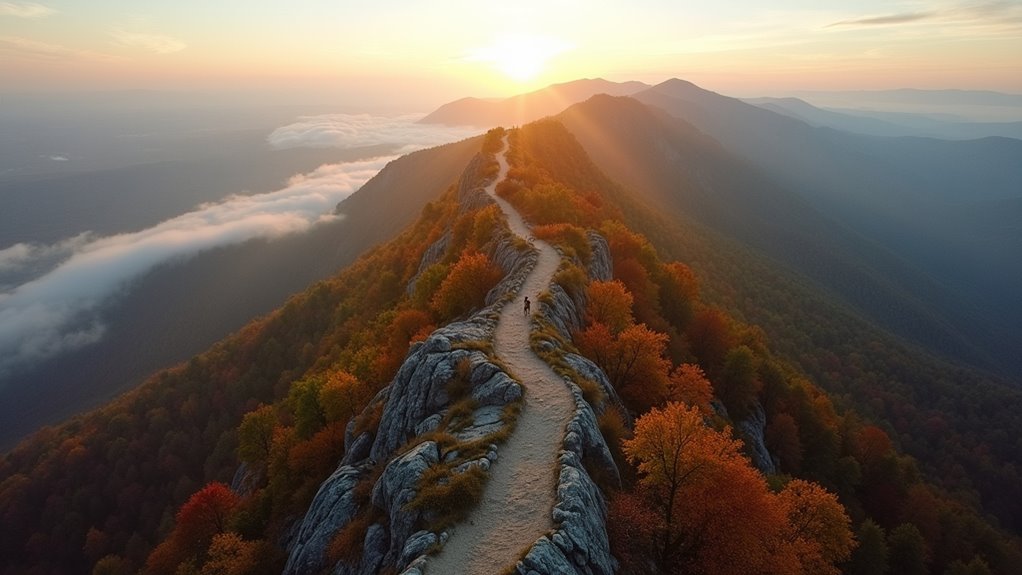
When you’re planning to tackle the entire Appalachian Trail, you’re committing to a journey that stretches 2,190 miles through 14 states, from Georgia’s Springer Mountain to Maine’s Mount Katahdin.
Most thru-hikers complete this epic adventure in 5-7 months, typically starting in early spring and finishing by fall.
The typical thru-hike spans nearly half a year, transforming spring beginners into seasoned fall finishers across America’s most iconic trail.
You’ll traverse diverse landscapes, from Southern hardwood forests to New England’s rugged peaks.
Each state offers unique challenges—Virginia’s endless ridges, Pennsylvania’s rocky terrain, and New Hampshire’s notorious White Mountains.
The trail passes through small mountain towns where you’ll experience genuine Appalachian hospitality and resupply your gear.
Weather becomes your constant companion, shifting from scorching Southern summers to potentially snowy Northern autumns.
Plan your timing carefully—most successful thru-hikers begin their northbound journey between March and April.
Before embarking on this monumental undertaking, consider what camping style best suits your preferences and experience level for the months ahead.
Behind this massive undertaking that takes months to complete lies a visionary idea from forester and planner Benton MacKaye. In 1921, MacKaye proposed the Appalachian Trail not just as a hiking path, but as a revolutionary solution to America’s growing urban-rural divide.
He envisioned the trail connecting overcrowded cities with pristine wilderness, offering stressed urban dwellers a chance to rejuvenate in nature.
MacKaye’s concept went beyond recreation. He imagined work camps, study centers, and food production facilities along the route, creating sustainable communities that bridged metropolitan and rural lifestyles.
His idea addressed post-World War I social concerns about industrialization’s impact on American society.
While his grander vision wasn’t fully realized, you’re experiencing his core philosophy every time you step onto the trail—reconnecting with nature and escaping urban pressures. Today’s hikers who follow MacKaye’s vision should practice responsible camping to preserve the wilderness experience he intended for future generations.
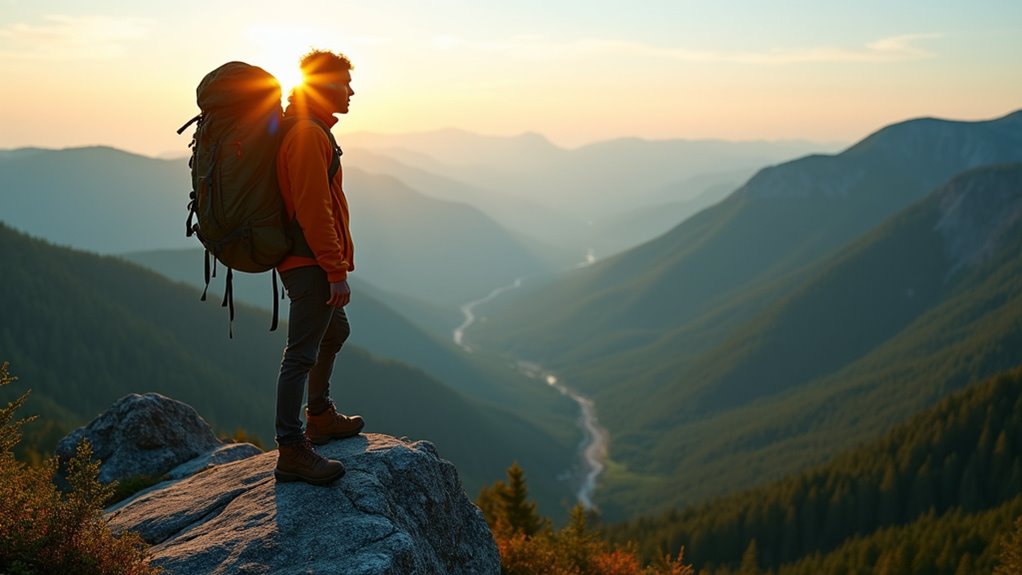
The exclusive club of Appalachian Trail thru-hikers remains remarkably small despite the trail’s fame. Since the trail’s completion, only about 3,000 people have successfully walked its entire 2,190-mile length in one continuous journey.
You’ll understand why when you consider the commitment required: most thru-hikers spend five to seven months covering 15-20 miles daily through challenging terrain and unpredictable weather.
The Appalachian Trail Conservancy maintains official records, but earning your spot requires hiking the entire trail within twelve months. You can’t just cherry-pick easy sections. Many attempt it, but only 25% actually finish.
Weather, injuries, financial constraints, and mental fatigue knock most people out. If you’re considering joining this elite group, prepare for one of America’s most demanding endurance challenges. Proper hydration becomes critical during these long hiking days, which is why many thru-hikers rely on intelligent water bottles to monitor their fluid intake throughout the journey.
Traversing those 2,190 miles wouldn’t be possible without the trail’s iconic white rectangular blazes that guide hikers from Georgia to Maine. You’ll find these painted markers every 100-200 feet, ensuring you never lose your way for long.
Each blaze measures roughly 2 inches by 6 inches and gets painted on trees, rocks, or posts by dedicated volunteers who maintain specific trail sections.
Two blazes stacked vertically signal an important turn ahead, while a single blaze confirms you’re heading in the right direction.
If you haven’t seen a blaze in several minutes, stop and backtrack—you’ve likely missed a turn.
Side trails use blue blazes, and yellow blazes mark other hiking paths.
These simple paint marks represent decades of volunteer work maintaining America’s most famous long-distance trail.
When you’re ready to set up camp for the night, these blazes will help guide you to suitable areas where you can consider the ideal camping spot based on terrain, water access, and Leave No Trace principles.
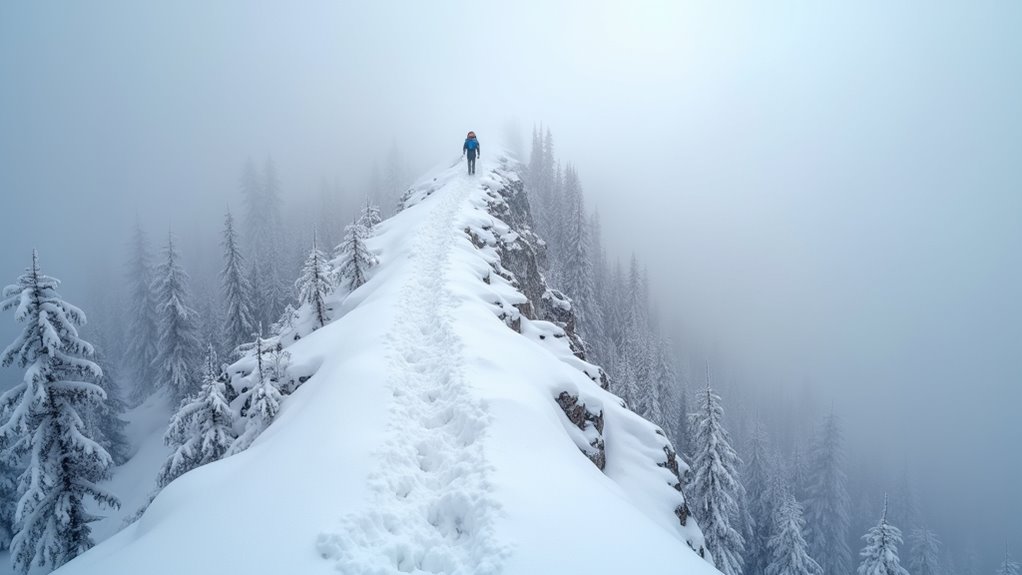
While Mount Washington’s 6,288-foot summit mightn’t seem intimidating compared to western peaks, it’s earned the nickname “Home of the World’s Worst Weather” for good reason. You’ll face hurricane-force winds exceeding 100 mph, sudden temperature drops of 50 degrees, and visibility that can vanish in minutes.
The mountain holds the world record for surface wind speed at 231 mph, recorded in 1934.
If you’re hiking this section of the AT, you’ll need serious preparation. Pack winter gear even in summer – hypothermia kills here year-round. Weather changes happen fast, so check conditions obsessively and don’t hesitate to turn back.
The mountain’s unique geography creates a collision zone where three major storm tracks meet, making conditions unpredictable and potentially deadly. Given these extreme conditions, following essential safety protocols becomes even more critical when attempting to summit Mount Washington.
Along your journey on the Appalachian Trail, you’ll encounter some of hiking’s most generous souls – Trail Angels who restore your faith in humanity when you need it most. These compassionate volunteers appear when you’re exhausted, offering everything from cold drinks to hot meals and sometimes even beds.
Trail Angels embody the hiking community‘s spirit of giving without expecting anything in return. They understand the physical and emotional challenges you’re facing because many have walked the trail themselves.
You’ll find their kindness transforms difficult days into memorable experiences. Just as outdoor enthusiasts debate whether to rent or buy equipment for their adventures, Trail Angels understand that sometimes the most valuable gifts can’t be purchased at any price.
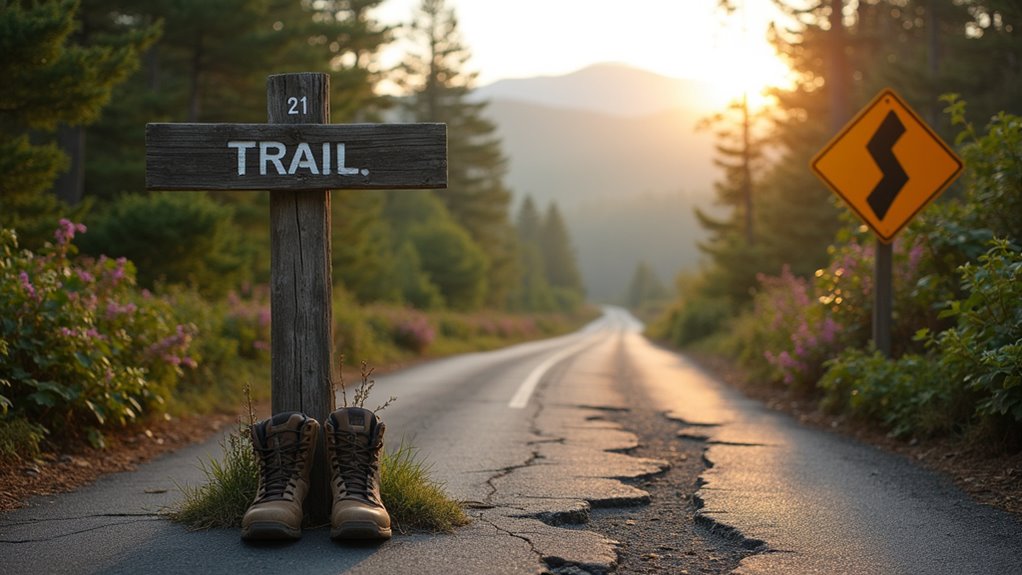
During your Appalachian Trail adventure, you’ll cross paved roads, dirt paths, and even busy highways more than 500 times – a reality that surprises many first-time thru-hikers who expect a purely wilderness experience.
These crossings aren’t just interruptions; they’re lifelines. You’ll resupply at nearby towns, grab hot meals, and sometimes hitch rides to hostels or grocery stores. Some crossings are simple dirt roads where you’ll barely pause, while others involve navigating busy intersections with traffic lights.
Smart hikers use these opportunities strategically. Plan your resupply stops around major road crossings to minimize detours. Download trail apps that show upcoming crossings and nearby amenities. Remember, these frequent intersections with civilization make the AT more accessible than many long-distance trails, allowing flexible entry and exit points throughout your journey.
When booking accommodations near these crossings, consider using credit card reservations for camping and lodging to provide additional security and flexibility for your payment methods.
Trail designers strategically placed shelters about 8-12 miles apart – roughly what most hikers can cover in a day. You’ll find these three-sided lean-tos equipped with sleeping platforms, though they’re first-come, first-served. Don’t count on snagging a spot during peak season – popular shelters fill up fast, especially around Damascus and Hot Springs.
Trail shelters fill quickly during peak hiking season, so savvy adventurers always carry backup camping gear for those inevitable full-house nights.
Each shelter features a privy, bear box for food storage, and nearby water source. You’ll discover trail registers where hikers share stories, warnings about weather, and encouragement for fellow adventurers. These become fascinating reads during rest stops.
Smart hikers always pack lightweight camping gear as shelter alternatives. Having a well-prepared wilderness survival kit can be crucial when shelters are unavailable or emergencies arise on the trail.
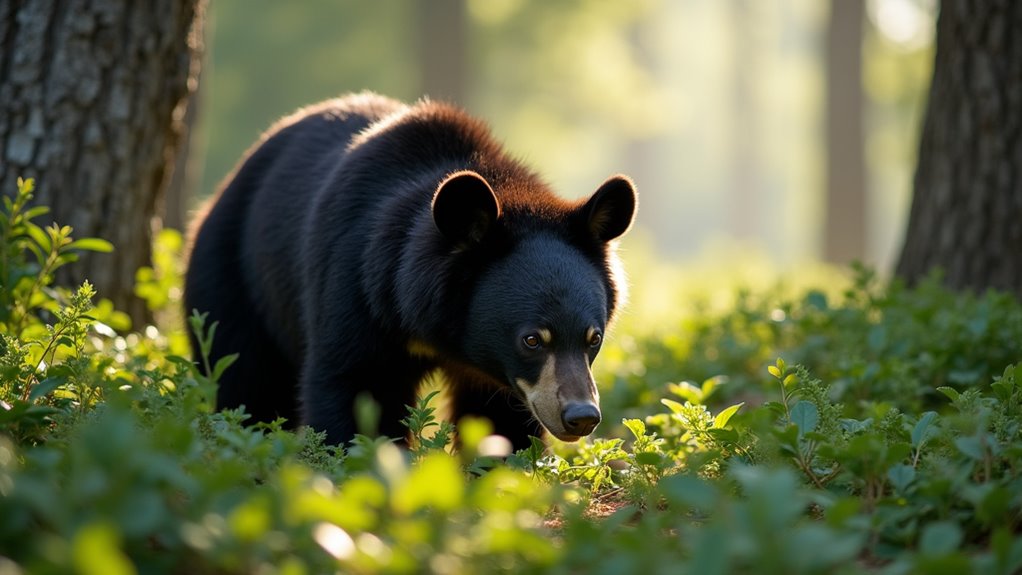
While black bears roam throughout the Appalachian Trail corridor from Georgia to Maine, you’re statistically more likely to get struck by lightning than attacked by one.
These intelligent animals typically avoid humans and will usually retreat when they encounter hikers.
You’ll increase your safety by following proper food storage protocols. Hang your food at least 12 feet high and 4 feet from tree trunks, or use bear canisters in required areas.
Never feed bears or leave food scraps around your campsite.
If you encounter a bear, don’t run. Make yourself appear large, speak calmly, and back away slowly.
Most bears are simply curious about potential food sources and will move on once they realize you’re not a threat.
When camping with children in bear country, engage them in fun camping activities that teach wildlife safety while keeping them entertained and aware of their surroundings.
Straddling the Tennessee-North Carolina border, Great Smoky Mountains National Park hosts the Appalachian Trail’s most popular section, drawing millions of visitors annually. You’ll traverse 71 miles through America’s most visited national park, experiencing diverse ecosystems from hardwood forests to spruce-fir summits.
The trail reaches its highest point in the Smokies at Clingmans Dome (6,643 feet), offering panoramic views when weather cooperates.
Key highlights you’ll encounter:
Expect crowds during peak seasons, but you’ll understand why this section captivates hikers worldwide with its biodiversity and mountain grandeur. When camping in this pristine wilderness, practice responsible camping to preserve the natural beauty for future generations.
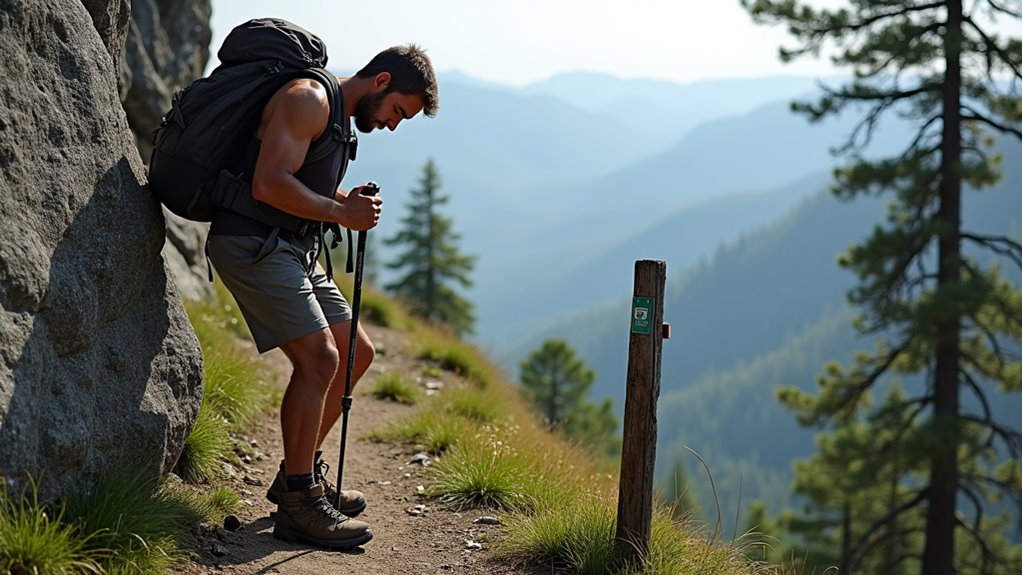
Completing the entire 2,190-mile Appalachian Trail will torch roughly one million calories—equivalent to eating 2,857 Big Macs or 11,111 glazed donuts. You’ll burn approximately 450 calories per hour while hiking, but this varies based on your weight, pack load, and terrain difficulty.
Most thru-hikers consume 4,000-6,000 calories daily yet still lose 20-30 pounds during their journey.
Plan your resupply strategy carefully—you can’t carry enough food for weeks at a time. Trail towns become lifelines where hikers famously devour enormous quantities of pizza, burgers, and ice cream.
This phenomenon, called “hiker hunger,” develops after weeks of caloric deficit. Your metabolism becomes a furnace, and you’ll find yourself obsessing over food in ways you never imagined possible.
Before embarking on such an extended wilderness adventure, consider securing travel insurance that covers hiking activities and emergency evacuations from remote trail locations.
Beyond the physical demands of burning calories and resupplying food, you’ll discover that earning a trail name represents one of hiking culture’s most cherished traditions. You won’t choose your own name—fellow hikers will bestow it upon you based on your personality, habits, or memorable moments on the trail.
Trail names aren’t chosen—they’re earned through memorable moments and bestowed by fellow hikers as badges of honor.
Trail names create instant bonds between strangers and become your identity in the hiking community. You’ll find that these nicknames often stick for life, even beyond the trail experience.
This tradition extends beyond solo adventures, as family camping trips often provide the perfect opportunity for parents and children to earn their first trail names together.
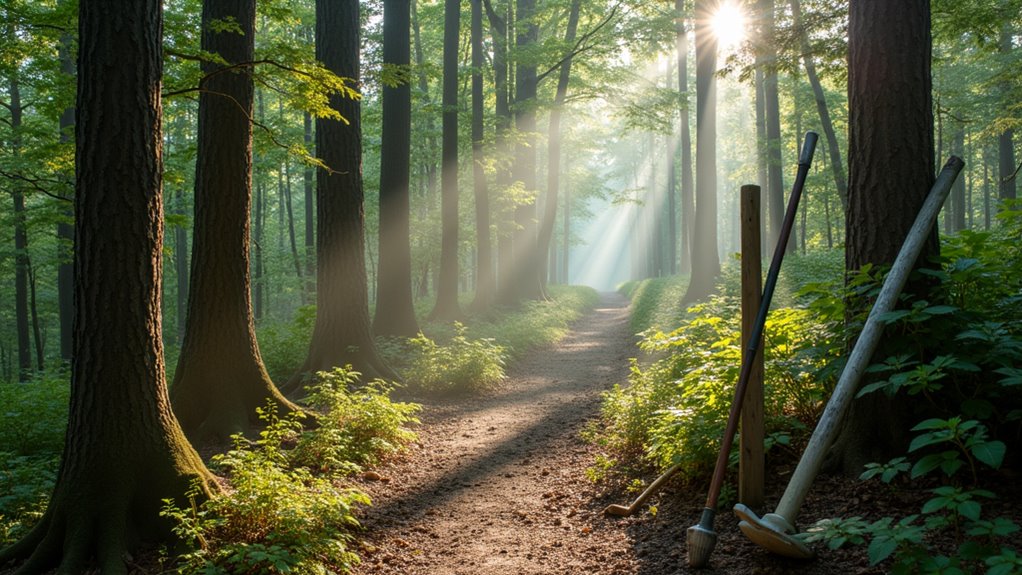
While thousands of hikers traverse the trail each year, the Appalachian Trail Conservancy (ATC) works tirelessly behind the scenes to guarantee your journey remains possible. Founded in 1925, this nonprofit organization coordinates over 6,000 volunteers who maintain the trail’s 2,190 miles.
They’re responsible for everything from clearing fallen trees to rebuilding damaged sections after storms.
You’ll notice their work in strategically placed blazes, well-maintained shelters, and clear trail markers. The ATC also protects the trail corridor through land acquisition and conservation easements, ensuring development doesn’t encroach on your wilderness experience.
They manage relationships with federal agencies, state governments, and local trail clubs across fourteen states. Without their dedication, the continuous footpath you’re hiking simply wouldn’t exist in its current pristine condition.
Similar conservation efforts exist worldwide, with bushwalking enthusiasts in Australia discovering the outdoors through their own network of maintained trails and wilderness experiences.
Standing 3,197 feet above sea level, McAfee Knob offers the iconic rocky outcrop view that’s graced countless social media feeds and hiking magazines. You’ll recognize this spot instantly – it’s the dramatic cliff where hikers pose with their legs dangling over the edge, showcasing Virginia’s Blue Ridge Mountains stretching endlessly behind them.
This 8.8-mile round-trip hike attracts thousands annually, making it one of the trail’s most crowded sections. You’ll encounter everyone from seasoned thru-hikers to weekend warriors seeking that perfect Instagram shot.
Many visitors treat this as part of a larger family camping experience, combining the day hike with overnight stays at nearby campgrounds to fully enjoy the Appalachian wilderness.
Planning your McAfee Knob adventure:
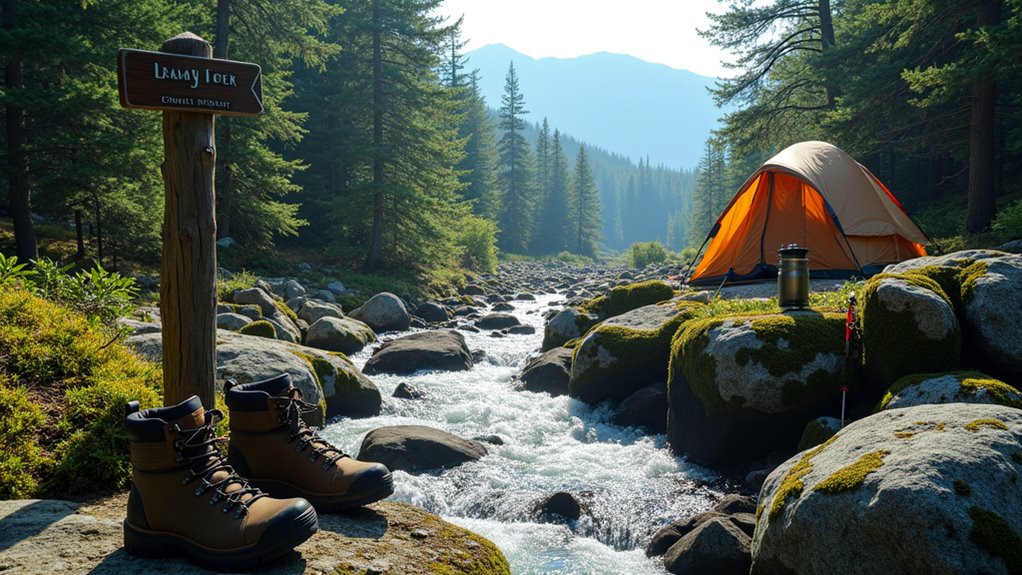
Every year, you’re contributing to a massive economic engine simply by hiking the Appalachian Trail. Your spending on gear, food, lodging, and transportation pumps over $1 billion into local communities along the 2,190-mile corridor.
When you resupply in trail towns like Damascus, Virginia, or Hanover, New Hampshire, you’re supporting small businesses that depend on hikers’ dollars.
Trail towns have transformed themselves into hiker-friendly destinations, offering everything from hostels and laundromats to gear shops and all-you-can-eat buffets. Your overnight stays generate tax revenue that funds local services and infrastructure improvements.
Even day hikers contribute considerably through gas purchases, restaurant meals, and grocery stops. This economic impact supports thousands of jobs and helps preserve the rural character that makes these communities special.
For those seeking a different adventure experience closer to urban areas, Chicago offers its own camping opportunities that combine city accessibility with outdoor recreation.
You’ll discover more than miles when you tackle the Appalachian Trail—you’ll uncover resilience you didn’t know you possessed, connections you never expected to make, and perspectives you couldn’t imagine from your everyday life. Whether you’re planning a weekend section hike or dreaming of a full thru-hike, you’re joining a community that’s shaped American outdoor culture for generations. Every white blaze leads somewhere extraordinary.